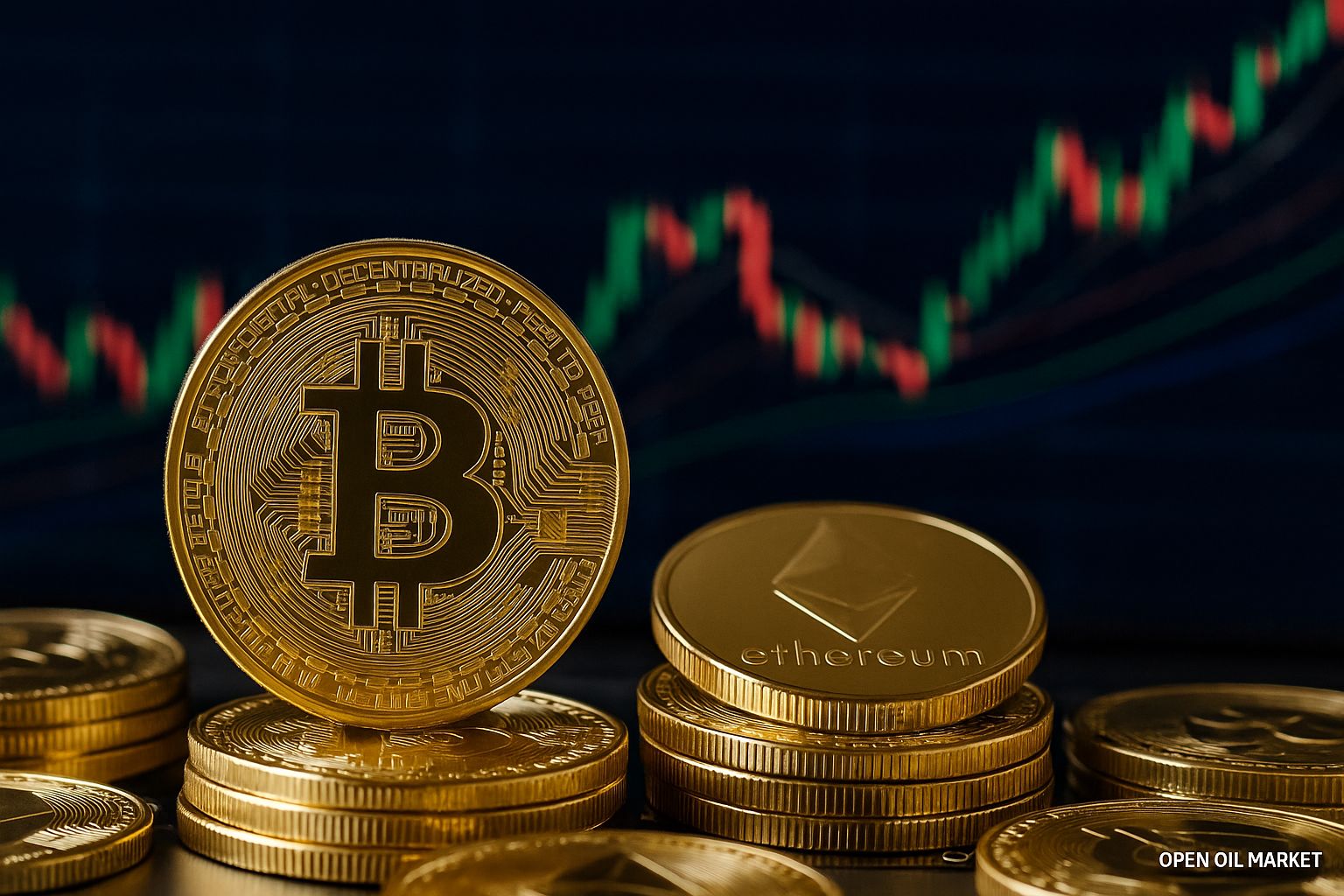
Detailed Overview of Economic Events and Corporate Reports on August 20, 2025. Brazil Discusses the Creation of a Bitcoin Reserve, Rate Decisions in China (LPR) and New Zealand, Consumer Inflation in the UK, Eurozone, and Russia, EIA Oil Inventory Data, Publication of the Fed Minutes, and Company Reports from the US, Europe, Asia, and Russia.
Wednesday brings a packed agenda for global markets. In Asia, attention is focused on monetary policy: China, facing deflationary risks and an economic slowdown, will announce its Loan Prime Rate (expected to remain at a record low of 3.0% following previous easing measures), while the Reserve Bank of New Zealand is expected to cut rates to support its slowing growth. In Europe, fresh inflation data will be in the spotlight: the consumer price growth rates in the UK and Eurozone for July will reveal how close regulators are to their target levels (the Eurozone indicator is already at 2%, while the UK is still significantly above target). In the Russian market, the inflation rate, remaining high by international standards, will affect the ruble exchange rate and the Bank of Russia's further actions. An unusual piece of news today will be the public hearings in Brazil regarding the creation of a national Bitcoin reserve: this precedent reflects the growing role of cryptocurrencies in the financial sector and may attract investor interest in digital assets.
The US session promises important signals for risk appetite: the minutes of the last Federal Reserve (FOMC) meeting will be released in the evening. Investors worldwide are eager for details on the Fed's leadership sentiments – any hints regarding the future trajectory of interest rates or assessments of economic risks could significantly impact bond yields, the dollar's exchange rate, and the dynamics of growth stocks. The energy market will be watching the weekly EIA data on US oil inventories, which will determine the short-term demand-supply balance for the commodity. On the corporate side, a series of reports from major companies are expected: results from retail, industrial, and tech leaders from different regions will be released before the market opens, followed by financial reports from key US technology sector players after the close. Investors will need to compare macroeconomic data and corporate results in combination: monetary decisions ↔ inflation trends ↔ commodity prices ↔ corporate profits – all these factors together will set the market tone for August 20.
Macroeconomic Calendar (MSK)
- 04:15 — China: Decision on the Loan Prime Rate (LPR).
- 05:00 — New Zealand: Reserve Bank's interest rate decision.
- 09:00 — UK: Consumer Price Index (CPI) for July.
- 12:00 — Eurozone: Consumer Price Index (CPI) for July.
- 17:30 — USA: Commercial oil inventories (EIA report) for the week.
- 19:00 — Russia: Consumer Price Index (CPI) (weekly data).
- 21:00 — USA: Minutes of the July FOMC meeting.
- 22:00 — Brazil: Parliamentary hearings on the creation of a national Bitcoin reserve.
Rate Decisions: China and New Zealand
- China (LPR): The People's Bank of China is expected to maintain the 1-year Loan Prime Rate at 3.0% for the third consecutive month. Earlier, in May, the rate was lowered to a record low, and the regulator now prefers targeted support measures instead of new broad easing. Investors will be looking for signals on how well Beijing can stimulate the economy without further large-scale rate cuts, considering deflation risks and weak demand.
- New Zealand: The Reserve Bank of New Zealand is expected to resume easing policy in light of a cooling economy. A 25 basis points cut in the Official Cash Rate (OCR) to 3.00% is anticipated. The easing of monetary policy in New Zealand aims to support domestic demand and the housing market. The RBNZ's decision may impact the New Zealand dollar (NZD) and set the tone for other small open economies' central banks balancing inflation and growth.
Inflation: UK, Eurozone, and Russia
- UK: The July CPI data will show price dynamics after an unexpected acceleration in inflation to 3.6% year-on-year in June (the highest since early 2024). Market expectations are that inflation will remain around 3.6-3.7%. The figure is significantly above the Bank of England's target of 2%, which keeps pressure on the regulator. Any deviation (for example, a slowdown below the forecast) could affect the pound's exchange rate and interest rate expectations: lower inflation would provide grounds for a dovish tone from the Bank of England, while a new spike in price growth would reinforce hawkish sentiments.
- Eurozone: Preliminary estimates suggest that annual inflation in the currency block held steady at 2.0% in July – exactly at the ECB's target and unchanged from June. This indicates successful pressure relief on prices: the era of double-digit inflation in Europe is behind. Investor attention will shift to the core CPI index, which remains above a comfortable level (around 2.7%). If final data confirms inflation stabilization at 2%, the European Central Bank may confidently maintain its pause on rate hikes, supporting the euro and the broader European stock markets.
- Russia: In Russia, inflation remains elevated: the year-on-year price index in July decreased to approximately 8.8% from 9.4% the previous month, indicating a gradual slowdown after the peak in the spring. However, the figure is still twice the Central Bank of Russia’s (CBR) target (4%). The CBR began a cycle of rate cuts in the summer (lowering it to 18% annually in July from the previous 20%), assessing that peak price pressure has passed. New weekly CPI data will help understand whether the disinflation trend persists. Reducing inflation opens the path for further easing of monetary policy, but the risks of a weakening ruble and fiscal stimulus make the regulator proceed cautiously.
Oil: EIA Inventories
The energy sector will be in focus today due to the release of the US Department of Energy's report on commercial oil inventories (EIA). This weekly data will provide a fresh view of the demand-supply balance in the world's largest oil market. Preliminary benchmarks are set by the American Petroleum Institute's (API) estimates released the night before: a significant reduction in inventories according to the API would hint at sustained demand and support prices, while an increase in inventories would signal weakened consumption or increased supply. Oil traders will react to the EIA figures immediately: significant deviations from forecasts could lead to spikes in volatility for Brent and WTI prices. Additionally, investors are considering the broader context: OPEC+ efforts to limit production and economic news from China (the largest oil importer) will shape the market environment, either reinforcing current trends or correcting them based on inventory statistics.
USA: Fed Minutes
At 21:00 MSK, the minutes from the Federal Reserve's meeting in late July will be released. This document is key to understanding FOMC sentiments. Investors look for answers to questions: how unanimous was the Fed's decision on interest rates, are there concerns about overheating or, conversely, economic slowdown, and were there hints at future policy changes discussed. In the last meeting, the Fed either maintained its rate or executed the final raise of the current cycle – now the details of the discussion are crucial. If the minutes indicate that some committee members are still worried about inflation and lean towards further tightening, markets might interpret this as a “hawkish” signal: treasury yields may rise, the dollar may strengthen, and high-risk assets may face pressure. However, signs of the Fed's willingness to pause or indications of an economic cooling could support equities and bonds. Particular attention will be given to the section of the minutes discussing inflation and growth forecasts: it will indicate how close the regulator sees the end of the period of high rates. Overall, the publication of the “minutes” has the potential to set the trajectory for the US market for the remainder of the week, reshaping investor expectations regarding the Fed's actions this fall.
Corporate Reports: Before Market Open (BMO, US and Asia)
- Walmart (WMT) — the world's largest retailer. Focus is on the comparable sales dynamics (LFL) in the US and international segments, consumer demand trends against moderate inflation, as well as management's forecast for the second half of the year. Walmart's results serve as a barometer for the health of the consumer sector — investors will evaluate how price growth and interest rates are impacting household spending.
- Target (TGT) — a large US discount retail chain. Key metrics: changes in comparable store sales, inventory levels, and profitability. Following a challenging first half of the year, the market is looking to see if Target has succeeded in restoring traffic and profitability through discounts and assortment optimization. Target's report will significantly influence the mood regarding mid-range retail stocks.
- Home Depot (HD) — a leading home improvement and repair retailer (Dow Jones, S&P 500). Important indicators: revenue figures in the DIY and professional customer segments in the US market, as high mortgage rates cool the housing market and could restrain repair spending. Investors will pay attention to the average transaction value and traffic, as well as comments on inventory and supply chain issues for building materials.
- Medtronic (MDT) — one of the global leaders in medical technologies and equipment. Watch for revenue growth in key areas (cardiology, neurotechnology, surgery) and geographic segments, especially dynamics in emerging markets. Profitability (operating margin) and management's forecasts for the financial year will also be in focus, as investors seek assurance that the recovery of scheduled operations in hospitals supports Medtronic device sales.
- Estee Lauder (EL) — a global manufacturer of cosmetics and luxury goods. Signals about recovering demand for premium cosmetics are crucial: particularly sales in the Asia-Pacific region (China) and dynamics in the travel segment (duty-free). Profit margins and earnings forecasts are also under scrutiny, given rising costs. Estee Lauder's results will impact the entire luxury goods and consumer products sector.
- TJX Companies (TJX) — the operator of off-price retail chains (T.J. Maxx, Marshalls). Key areas to watch include sales on comparable store sites and inventory levels. Investors will evaluate whether the off-price segment is benefitting from consumers seeking discounts in an expensive living environment. Comments on gross margins (considering a strong dollar and changing import costs) and expansion strategies will also be important.
- XPeng (XPEV) — a Chinese electric vehicle manufacturer listed in the US. Metrics include quarterly electric vehicle delivery volumes, revenue growth rates, as well as cash reserves and cost efficiency. Investors want to see XPeng's progress in reducing losses and competing with leaders in the Chinese EV market. Management comments on government support for the sector and expansion into overseas markets will also be significant.
- Baidu (BIDU) — the largest search and AI company in China (NASDAQ). Focus: recovery of advertising revenues (core business) amid improving economic conditions in China, growth in cloud services, and new initiatives in artificial intelligence. Baidu's success in autonomous driving and other innovative projects will be particularly interesting. Baidu's results will serve as an indicator for the entire Chinese tech sector.
- Alibaba (BABA) — the leading e-commerce platform and IT conglomerate in China. Key aspects of the report: dynamics of gross merchandise volume (GMV) on trading platforms, indicators from the Alibaba Cloud division, as well as the progress of the company's structural reorganization (splitting into several business groups). Investors will assess how weak consumer demand in China and competition affect results. Additionally, updates are expected on the share buyback program, which could bolster the company's capitalization.
- Analog Devices (ADI) — a manufacturer of analog and mixed-signal semiconductors. Attention will be on demand from industrial clients and the automotive sector (key markets for ADI), as well as trends in orders for chips in energy and communications. Gross margin is also crucial — how the company is coping with potential oversupply and price declines. ADI's forecasts for the industry could provide benchmarks for the entire chip sector amid a cyclical downturn in electronics demand.
Corporate Reports: After Market Close (AMC, US)
- Palo Alto Networks (PANW) — a leader in cybersecurity. Investors expect steady revenue growth and, crucially, the billings metric (volume of new orders), which reflects future demand for products. Operational margin will also be in focus, as the company actively invests in cloud solutions and artificial intelligence for network security. Palo Alto's forecasts will be an indicator of corporate IT budgets for cybersecurity.
- Intuit (INTU) — a developer of financial software for businesses and individuals (TurboTax, QuickBooks). Key indicators: number of subscribers and average transaction value in the small business segment (QuickBooks ecosystem), as well as the dynamics of the TurboTax tax reporting service. Following major acquisitions (Credit Karma, Mailchimp), investors will evaluate integration and synergy. In the context of financial digitalization, Intuit aims to maintain high growth rates and expand profitability.
- Zoom (ZM) — a video conferencing platform provider. The key question is whether Zoom can maintain and grow its corporate client base in a post-pandemic reality filled with competitors (Microsoft Teams, Webex). Metrics of focus: revenue growth from major corporate clients, dynamics of new products (Zoom Phone, office solutions), and customer retention rate. Investors will also monitor profitability: Zoom is optimizing costs while balancing investments in new features (e.g., AI integration) and maintaining profitability.
Other Regions and Indices: Euro Stoxx 50, Nikkei 225, MOEX
- Euro Stoxx 50: As of August 20, significant corporate releases among the blue-chip stocks in the Eurozone are limited — the main reporting season for Q2 has already concluded at the end of July. European markets are primarily focused on macro data (inflation in the UK and Eurozone) and currency/bond dynamics. Price stabilization in the region and a pause from the ECB create a moderately positive backdrop for the Euro Stoxx 50 index, but unexpected inflation surprises or geopolitical news could alter predictions.
- Nikkei 225 / Japan: The financial reporting season for April–June is wrapping up in Japan. Most major corporations (auto manufacturers, electronics) have already reported results, and the overall impression is favorable — profits of many companies have increased against a backdrop of a weak yen. On August 20, there will be some releases from second-tier companies (industrial firms, manufacturers of automotive components), which are unlikely to significantly influence the index. Investor attention is shifting to macroeconomic factors: yen exchange rate, Bank of Japan policy, and external markets. The Nikkei 225 remains close to multi-decade highs, indicating strong investor confidence in Japanese assets.
- MOEX / Russia: The Russian market continues to see a series of publications of operating and interim results from various issuers, but major reports from the largest companies for the first half of the year are concentrated in the second half of August and early September. Thus, on August 20, the emphasis will likely be on macro events (inflation, ruble exchange rate) and external factors. Some energy and retail companies may provide trading updates or accounting reports under RAS, but these typically do not have a wide-ranging impact on the MOEX index. Traditionally, the peak of half-year reporting from Russian blue chips falls in the last weeks of August, which will be a key driver for the local market in the upcoming period.
Summary of the Day: What to Watch for Investors
- Inflation Data (UK and Eurozone): Morning CPI figures from the UK and Eurozone will set the tone for European trading. If UK inflation comes out higher than expected, discussions about further rate hikes from the Bank of England may intensify (pressuring the FTSE 100 and increasing government bond yields). Conversely, stabilization of inflation at 2% in the Eurozone would confirm the end of the price surge – this is positive for bonds and stocks in the region, reducing the likelihood of new ECB moves.
- Fed Minutes (FOMC): In the evening, investors worldwide will be closely reading the Fed minutes. It is critical for the markets to determine whether the minutes display the Fed’s inclination for further tightening or signaling a pause. “Hawkish” tones (emphasizing persistent inflation, readiness to raise rates again) may lead to dollar strength and downward pressure on US stock indices. Conversely, a more neutral or “dovish” protocol (indicating economic slowdown, lack of consensus on new rate hikes) would support stocks, especially in the tech sector.
- Monetary Decisions in the APEC Region: Maintaining a accommodative monetary policy stance in the Asia-Pacific region will serve as an important backdrop. If China’s decision on the LPR remains unchanged, it will confirm that Beijing is relying on targeted stimuli rather than "cheap money" — an important factor for commodity markets and currencies in developing countries. If a rate cut in New Zealand occurs, it may weaken the New Zealand dollar and signal a turning point toward easing among developed economies, which global investors will consider in their currency and bond strategies.
- Oil Market: The combination of the EIA inventory report and other factors (OPEC+, demand in China) will determine the dynamics of oil prices. A sharp decline in US inventories, coupled with continued Saudi production limits, could push Brent prices up — this would support oil and gas company stocks but could amplify inflation expectations in the market. If inventories unexpectedly increase, oil prices may temporarily drop, cooling the rally in energy assets witnessed in recent days.
- Corporate Reports: Before market open, the focus will be on the US retail sector — results from Walmart and Target will show the state of consumer demand, setting the tone for retailer stocks. Strong reports will indicate household spending resilience, while weak ones will heighten recession fears. After market close, attention will shift to the tech sector: forecasts from Palo Alto Networks (cybersecurity) and Zoom (communications) will be indicators of corporate IT spending. Volatility in individual stocks may be high, but overall, the earnings season is nearing completion, and surprises from specific companies may only distract from the macroeconomic picture in the short term.
- Cryptocurrencies and New Initiatives: Historic hearings in the Brazilian parliament regarding the creation of a Bitcoin reserve are a noteworthy event being closely watched by the crypto market. While this discussion is unlikely to have a direct impact on traditional markets, the very fact of a large economy's interest in implementing cryptocurrencies at a state level enhances trust in digital assets. Should this news develop further, it could stimulate Bitcoin's price increase and lift stocks related to the crypto industry. Investors diversifying into crypto assets should pay attention to regulatory steps from major countries — these shape long-term trends in the crypto market.




